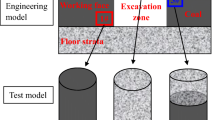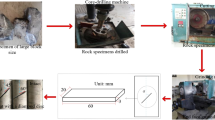Abstract
In coal mining engineering, the mechanical properties of rocks in coal-bearing formations are important for mining safety. In addition, lithological properties are among the most crucial factors affecting the mechanical properties of a given rock. To preliminarily address this important issue, several uniaxial compression tests were conducted on three types of rocks in coal-bearing formations: argillaceous siltstone, mudstone and silty mudstone. In all of the experiments, the acoustic emission (AE) technique was employed to detect the initiation and evolution of microcracks during the testing process, and the computed tomography method was then employed to further investigate the failure patterns of the different types of rock mass. The AE results showed that failure initiated at stress levels of approximately 0.18, 0.48 and 0.05 times the peak stresses for argillaceous siltstone, mudstone and silty mudstone, respectively. Furthermore, in the argillaceous siltstone, the accumulated AE events increased gradually during loading until macrofailure occurred; in contrast, obvious plateaus in the AE parameter curves existed in the stress regions at 60–70% and 35.5–50% peak stress for mudstone and silty mudstone, respectively. In the crack coalescence stage, a large number of low-energy microfractures occurred in the argillaceous siltstone, whereas a small number of high-energy microfractures occurred in the mudstone and silty mudstone. The results revealed that (1) the argillaceous siltstone was essentially destroyed by splitting, while the mudstone and silty mudstone samples were broken by shear fracture propagation; (2) for all of the coal-bearing formation rocks investigated in this work, when the fracture surface area was larger, the strain energy to be translated into surface energy was greater, and thus, more input energy was required when the peak strength was greater. Clearly, lithological properties, especially microstructural features, play a critical role in the mechanical properties of coal-bearing formation rocks. Therefore, a comprehensive evaluation should be considered in any analysis of mining safety.






Similar content being viewed by others
Abbreviations
- A f :
-
Total area of fractures
- FI:
-
Fracture intensity, fracture volume per unit sample volume
- S e :
-
Strain energy density
- t :
-
Time
- P 32 :
-
Fracture intensity, fracture area per unit volume of the region being measured
- UCS:
-
Uniaxial compressive strength
- U d :
-
Total energy required to generate new surfaces
- U e :
-
Total strain energy of a sample during loading
- V f :
-
Fracture volume inside a rock sample
- V v :
-
Total volume of the region being measured
- V 0 :
-
Initial volume of a sample
- Γ :
-
Surface energy density
References
Agioutantis Z, Kaklis K, Mavrigiannakis S, Verigakis M, Vallianatos F, Saltas V (2016) Potential of acoustic emissions from three point bending tests as rock failure precursors. Int J Min Sci Technol 26(1):155–160
Ai T, Zhang R, Liu J, Ren L (2012) Space-time evolution rules of acoustic emission location of unloaded coal sample at different loading rates. Int J Min Sci Technol 22(6):847–854
Barbour TG, Ko HY (1979) Relationship of mechanical, index, and mineralogic properties of coal measure rock. Paper presented at the 20th U.S. symposium on rock mechanics (USRMS), Austin, Texas, 1979/1/1/
Basarir H, Karpuz C, Tutluoglu L (2008) Specific energy based rippability classification system for coal measure rock. J Terrramech 45(1):51–62
Benson PM, Thompson BD, Meredith PG, Vinciguerra S, Young RP (2007) Imaging slow failure in triaxially deformed Etna basalt using 3D acoustic-emission location and X-ray computed tomography. Geophys Res Lett 34(3):300–315
Cai M, Kaiser PK, Tasaka Y, Maejima T, Morioka H, Minami M (2004) Generalized crack initiation and crack damage stress thresholds of brittle rock masses near underground excavations. Int J Rock Mech Min Sci 41(5):833–847
Chen D, Wang E, Li N (2017) Analyzing the rules of fracture and damage, and the characteristics of the acoustic emission signal of a gypsum specimen under uniaxial loading. J Geophys Eng 14(4):780–791
Faisal TF, Awedalkarim A, Chevalier S, Jouini MS, Sassi M (2017) Direct scale comparison of numerical linear elastic moduli with acoustic experiments for carbonate rock X-ray CT scanned at multi-resolutions. J Pet Sci Eng 152:653–663
Frash LP, Carey JW, Lei Z, Rougier E, Ickes T, Viswanathan HS (2016) High-stress triaxial direct-shear fracturing of Utica shale and in situ X-ray microtomography with permeability measurement. J Geophys Res Solid Earth 121(7):5493–5508
Hedayat A, Pyrak-Nolte LJ, Bobet A (2014) Detection and quantification of slip along non-uniform frictional discontinuities using digital image correlation. Geotech Test J 37(5):20130141
Ishida T et al (2017) ISRM suggested method for laboratory acoustic emission monitoring. Rock Mech Rock Eng 50(3):665–674
J.Pyrak-Nolte L, Roy S, L.Mullenbach B (1996) Interface waves propagated along a fracture. J Appl Geophys 35:79–87
Kahraman S (2001) Evaluation of simple methods for assessing the uniaxial compressive strength of rock. Int J Rock Mech Min Sci 38(7):981–994
Karacan C (2009) Reservoir rock properties of coal measure strata of the Lower Monongahela Group, Greene County (Southwestern Pennsylvania), from methane control and production perspectives. Int J Coal Geol 78(1):47–64
Kong B, Wang E, Li Z, Wang X, Liu J, Li N (2016) Fracture mechanical behavior of sandstone subjected to high-temperature treatment and its acoustic emission characteristics under uniaxial compression conditions. Rock Mech Rock Eng 49(12):4911–4918
Lee C, Lee C, Yeh H, Lin H (2011) Modeling spatial fracture intensity as a control on flow in fractured rock. Environ Earth Sci 63(6):1199–1211
Liu Q, Xu J, Liu X, Jiang J, Liu B (2015) The role of flaws on crack growth in rock-like material assessed by AE technique. Int J Fract 193(2):1–17
Luo Y, Ren L, Xie LZ, Ai T, He B (2017) Fracture behavior investigation of a typical sandstone under mixed-mode I/II loading using the notched deep beam bending method. Rock Mech Rock Eng 50(8):1987–2005
Maurício A, Figueiredo C, Alves C, Pereira M (2013) Non-destructive microtomography-based imaging and measuring laboratory-induced degradation of travertine, a random heterogeneous geomaterial used in urban heritage. Environ Earth Sci 69(4):1471–1480
Mavrogordato M, Taylor M, Taylor A, Browne M (2010) Acoustic emission monitoring and 3D visualization of polymerization-induced damage of acrylic polymer materials. J Biomed Mater Res Part B Appl Biomater 90B(1):223–228
McNally GH (1987) Estimation of coal measures rock strength using sonic and neutron logs. Geoexploration 24(4):381–395
Mishra B, Nie D (2013) Experimental investigation of the effect of change in control modes on the post-failure behavior of coal and coal measures rock. Int J Rock Mech Min Sci 60(12):363–369
Mishra B, Verma P (2015) Uniaxial and triaxial single and multistage creep tests on coal-measure shale rocks. Int J Coal Geol 137:55–65
Modiriasari A, Bobet A, Pyrak-Nolte LJ (2017) Active seismic monitoring of crack initiation, propagation, and coalescence in rock. Rock Mech Rock Eng 50:2311–2325
Pei J, Fei W, Liu J (2016) Spatial evolution and fractal characteristics of natural fractures in marbles under uniaxial compression loading based on the source location technology of acoustic emission. Environ Earth Sci 75(9):828
Pyrak-Nolte LJ, Roy S (2000) Monitoring fracture evolution with compressional-mode interface waves. Geophys Res Lett 27(20):3397–3400
Pyrak-Nolte LJ, Myer LR, Cook NGW (1990) Transmission of seismic waves across single natural fractures. J Geophys Res 95(B6):8617–8638
Ren L, Xie LZ, Xie HP, Ai T, He B (2016) Mixed-mode fracture behavior and related surface topography feature of a typical sandstone. Rock Mech Rock Eng 49(8):3137–3153
Rusnak J, Mark C (2000) Using the point load test to determine the uniaxial compressive strength of coal measure rock. In: The 19th international conference on ground control in mining, Morgantown, WV: West Virginia University, pp 362–371
Shields Y, Garboczi E, Weiss J, Farnam Y (2018) Freeze–thaw crack determination in cementitious materials using 3D X-ray computed tomography and acoustic emission. Cem Concr Compos 89:120–129
Su F, Itakura K, Deguchi G, Ohga K (2017) Monitoring of coal fracturing in underground coal gasification by acoustic emission techniques. Appl Energy 189:142–156
Viggiani G, Lenoir N, Bésuelle P, Michiel MD, Marello S, Desrues J, Kretzschmer M (2004) X-ray microtomography for studying localized deformation in fine-grained geomaterials under triaxial compression. Comptes Rendus Mécanique 332(10):819–826
Wang G, Chu X, Yang X (2016a) Numerical simulation of gas flow in artificial fracture coal by three-dimensional reconstruction based on computed tomography. J Nat Gas Sci Eng 34:823–831
Wang J et al (2016b) Effect of layer orientation on acoustic emission characteristics of anisotropic shale in Brazilian tests. J Nat Gas Sci Eng 36:1120–1129
Wu S, Ge H, Wang X, Meng F (2017) Shale failure processes and spatial distribution of fractures obtained by AE monitoring. J Nat Gas Sci Eng 41:82–92
Zhang R, Ai T, Zhou HW, Ju Y, Zhang ZT (2015a) Fractal and volume characteristics of 3D mining-induced fractures under typical mining layouts. Environ Earth Sci 73(10):6069–6080
Zhang R, Dai F, Gao MZ, Xu NW, Zhang CP (2015b) Fractal analysis of acoustic emission during uniaxial and triaxial loading of rock. Int J Rock Mech Min Sci 79:241–249
Zhang Z, Wang E, Chen D, Li X, Li N (2016) The observation of AE events under uniaxial compression and the quantitative relationship between the anisotropy index and the main failure plane. J Appl Geophys 134:183–190
Zhou XP, Zhang YX, Ha QL (2008) Real-time computerized tomography (CT) experiments on limestone damage evolution during unloading. Theor Appl Fract Mech 50(1):49–56
Zhu JB, Zhou T, Liao ZY, Sun L, Li XB, Chen R (2018) Replication of internal defects and investigation of mechanical and fracture behaviour of rock using 3D printing and 3D numerical methods in combination with X-ray computerized tomography. Int J Rock Mech Min Sci 106:198–212
Acknowledgements
The financial support from the National Natural Science Foundation of China (Grant no. 51622402) and Department of Science and Technology of Sichuan Province (CN) (Grant no. 2017TD0007) is highly appreciated. The authors also thank anonymous colleagues for their kind efforts and valuable comments, which have improved this work.
Author information
Authors and Affiliations
Corresponding author
Additional information
Publisher’s Note
Springer Nature remains neutral with regard to jurisdictional claims in published maps and institutional affiliations.
Rights and permissions
About this article
Cite this article
Zhang, R., Ai, T., Ren, L. et al. Failure Characterization of Three Typical Coal-Bearing Formation Rocks Using Acoustic Emission Monitoring and X-ray Computed Tomography Techniques. Rock Mech Rock Eng 52, 1945–1958 (2019). https://doi.org/10.1007/s00603-018-1677-9
Received:
Accepted:
Published:
Issue Date:
DOI: https://doi.org/10.1007/s00603-018-1677-9




